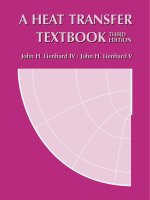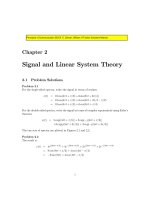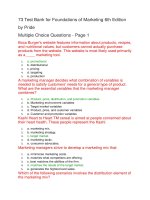Borgnakke sonntag fundamentals of thermodynamics 6th edition ~ team tolly
Bạn đang xem bản rút gọn của tài liệu. Xem và tải ngay bản đầy đủ của tài liệu tại đây (20.67 MB, 2,257 trang )
SOLUTION MANUAL
SI UNIT PROBLEMS
CHAPTER 2
FUNDAMENTALS
of
Thermodynamics
Sixth Edition
SONNTAG
•
BORGNAKKE
•
VAN WYLEN
CONTENT
SUBSECTION PROB NO.
Correspondence table
Concept-Study Guide Problems 1-22
Properties and Units 23-26
Force and Energy 27-37
Specific Volume 38-43
Pressure 44-57
Manometers and Barometers 58-76
Temperature 77-80
Review Problems 81-86
Sonntag, Borgnakke and van Wylen
Correspondence table
CHAPTER 2 6
th
edition Sonntag/Borgnakke/Wylen
The correspondence between the problem set in this sixth edition versus the
problem set in the 5'th edition text. Problems that are new are marked new and
those that are only slightly altered are marked as modified (mod).
Study guide problems 2.1-2.22 and 2.23-2.26 are all new problems.
New 5
th
Ed. New 5
th
Ed. New 5
th
Ed.
27 1 47 new 67 24
28 new 48 16 68 new
29 2 49 17 69 new
30 new 50 new 70 23
31 3 51 new 71 new
32 new 52 19 72 30
33 5 53 new 73 32
34 6 54 34 74 33
35 7 55 29 75 new
36 9 56 new 76 37
37 10 57 28 mod 77 27
38 12 58 new 78 new
39 new 59 20 79 38
40 new 60 26 80 new
41 new 61 new 81 31
42 11 62 21 82 new
43 13 63 new 83 22
44 new 64 new 84 35
45 18 65 15 85 36
46 14 66 new 86 new
English Unit Problems
New 5
th
Ed. SI New 5
th
Ed. SI
87 new - 97 43E 43
88 new 11 98 new 50
89 new 12 99 new 53
90 new 19 100 45E 70
91 new 20 101 46E 45
92 new 24 102 new 82
93 39E 33 103 48E 55
94 40E - 104 new 80
95 new 47 105 47E 77
96 42E 42
Design and Open ended problems 106-116 are from 5
th
edition problems 2.50-
2.60
Sonntag, Borgnakke and van Wylen
Concept-Study Guide Problems
2.1
Make a control volume around the turbine in the steam power plant in Fig. 1.1 and
list the flows of mass and energy that are there.
Solution:
We see hot high pressure steam flowing in
at state 1 from the steam drum through a
flow control (not shown). The steam leaves
at a lower pressure to the condenser (heat
exchanger) at state 2. A rotating shaft gives
a rate of energy (power) to the electric
generator set.
W
T
1
2
Sonntag, Borgnakke and van Wylen
2.2
Make a control volume around the whole power plant in Figure 1.2 and with the help
of Fig. 1.1 list what flows of mass and energy are in or out and any storage of
energy. Make sure you know what is inside and what is outside your chosen C.V.
Solution:
Smoke
stack
Boiler
building
Coal conveyor system
Dock
Turbine house
Storage
gypsum
Coal
storage
flue
gas
cb
Underground
power cable
W
electrical
Hot water
District heating
m
Coal
m
m
Flue gas
Storage for later
Gypsum, fly ash, slag
transport out:
Cold return
m
m
Combustion air
Sonntag, Borgnakke and van Wylen
2.3
Make a control volume that includes the steam flow around in the main turbine loop
in the nuclear propulsion system in Fig.1.3. Identify mass flows (hot or cold) and
energy transfers that enter or leave the C.V.
Solution:
W
electrical
1
2
W
T
1
3
Electric
power gen.
5
4
6
7
Cooling by seawater
Condensate
to steam gen.
cold
Hot steam from generator
cb
The electrical power
also leaves the C.V.
to be used for lights,
instruments and to
charge the batteries.
Sonntag, Borgnakke and van Wylen
2.4
Take a control volume around your kitchen refrigerator and indicate where the
components shown in Figure 1.6 are located and show all flows of energy transfer.
Solution:
The valve and the
cold line, the
evaporator, is
inside close to the
inside wall and
usually a small
blower distributes
cold air from the
freezer box to the
refrigerator room.
cb
W
.
Q
.
Q
leak
The black grille in
the back or at the
bottom is the
condenser that
gives heat to the
room air.
The compressor
sits at the bottom.
Sonntag, Borgnakke and van Wylen
2.5
An electric dip heater is put into a cup of water and heats it from 20
o
C to 80
o
C.
Show the energy flow(s) and storage and explain what changes.
Solution:
Electric power is converted in the heater
element (an electric resistor) so it becomes
hot and gives energy by heat transfer to
the water. The water heats up and thus
stores energy and as it is warmer than the
cup material it heats the cup which also
stores some energy. The cup being
warmer than the air gives a smaller
amount of energy (a rate) to the air as a
heat loss.
W
electric
Q
loss
C
B
Sonntag, Borgnakke and van Wylen
2.6
Separate the list P, F, V, v, ρ, T, a, m, L, t and V into intensive, extensive and non-
properties.
Solution:
Intensive properties are independent upon mass: P, v, ρ, T
Extensive properties scales with mass: V, m
Non-properties: F, a, L, t, V
Comment: You could claim that acceleration a and velocity V are physical
properties for the dynamic motion of the mass, but not thermal properties.
Sonntag, Borgnakke and van Wylen
2.7
An escalator brings four people of total 300 kg, 25 m up in a building. Explain what
happens with respect to energy transfer and stored energy.
Solution:
The four people (300 kg) have their
potential energy raised, which is how
the energy is stored. The energy is
supplied as electrical power to the
motor that pulls the escalator with a
cable.
Sonntag, Borgnakke and van Wylen
2.8
Water in nature exist in different phases like solid, liquid and vapor (gas). Indicate
the relative magnitude of density and specific volume for the three phases.
Solution:
Values are indicated in Figure 2.7 as density for common substances. More
accurate values are found in Tables A.3, A.4 and A.5
Water as solid (ice) has density of around 900 kg/m
3
Water as liquid has density of around 1000 kg/m
3
Water as vapor has density of around 1 kg/m
3
(sensitive to P and T)
Sonntag, Borgnakke and van Wylen
2.9
Is density a unique measure of mass distribution in a volume? Does it vary? If so, on
what kind of scale (distance)?
Solution:
Density is an average of mass per unit volume and we sense if it is not evenly
distributed by holding a mass that is more heavy in one side than the other.
Through the volume of the same substance (say air in a room) density varies only
little from one location to another on scales of meter, cm or mm. If the volume
you look at has different substances (air and the furniture in the room) then it can
change abruptly as you look at a small volume of air next to a volume of
hardwood.
Finally if we look at very small scales on the order of the size of atoms the density
can vary infinitely, since the mass (electrons, neutrons and positrons) occupy very
little volume relative to all the empty space between them.
Sonntag, Borgnakke and van Wylen
2.10
Density of fibers, rock wool insulation, foams and cotton is fairly low. Why is that?
Solution:
All these materials consists of some solid substance and mainly air or other gas.
The volume of fibers (clothes) and rockwool that is solid substance is low
relative to the total volume that includes air. The overall density is
ρ =
m
V
=
m
solid
+ m
air
V
solid
+ V
air
where most of the mass is the solid and most of the volume is air. If you talk
about the density of the solid only, it is high.
Sonntag, Borgnakke and van Wylen
2.11
How much mass is there approximately in 1 L of mercury (Hg)? Atmospheric air?
Solution:
A volume of 1 L equals 0.001 m
3
, see Table A.1. From Figure 2.7 the density is
in the range of 10 000 kg/m
3
so we get
m = ρV = 10 000 kg/m
3
× 0.001 m
3
= 10 kg
A more accurate value from Table A.4 is ρ = 13 580 kg/m
3
.
For the air we see in Figure 2.7 that density is about 1 kg/m
3
so we get
m = ρV = 1 kg/m
3
× 0.001 m
3
= 0.001 kg
A more accurate value from Table A.5 is ρ = 1.17 kg/m
3
at 100 kPa, 25
o
C.
Sonntag, Borgnakke and van Wylen
2.12
Can you carry 1 m
3
of liquid water?
Solution:
The density of liquid water is about 1000 kg/m
3
from Figure 2.7, see also Table
A.3. Therefore the mass in one cubic meter is
m = ρV = 1000 kg/m
3
× 1 m
3
= 1000 kg
and we can not carry that in the standard gravitational field.
2.13
A manometer shows a pressure difference of 1 m of liquid mercury. Find ∆P in kPa.
Solution:
Hg : L = 1 m; ρ = 13 580 kg/m
3
from Table A.4 (or read Fig 2.7)
The pressure difference ∆P balances the column of height L so from Eq.2.2
∆P = ρ g L = 13 580 kg/m
3
× 9.80665 m/s
2
× 1.0 m × 10
-3
kPa/Pa
= 133.2 kPa
Sonntag, Borgnakke and van Wylen
2.14
You dive 5 m down in the ocean. What is the absolute pressure there?
Solution:
The pressure difference for a column is from Eq.2.2 and the density of water is
from Table A.4.
∆P = ρgH
= 997 kg/m
3
× 9.81 m/s
2
× 5 m
= 48 903 Pa = 48.903 kPa
P
ocean
= P
0
+ ∆P
= 101.325 + 48.903
= 150 kPa
Sonntag, Borgnakke and van Wylen
2.15
What pressure difference does a 10 m column of atmospheric air show?
Solution:
The pressure difference for a column is from Eq.2.2
∆P = ρgH
So we need density of air from Fig.2.7, ρ = 1.2 kg/m
3
∆P = 1.2 kg/m
3
× 9.81 ms
-2
× 10 m = 117.7 Pa = 0.12 kPa
Sonntag, Borgnakke and van Wylen
2.16
The pressure at the bottom of a swimming pool is evenly distributed. Suppose we
look at a cast iron plate of 7272 kg lying on the ground with an area of 100 m
2
. What
is the average pressure below that? Is it just as evenly distributed?
Solution:
The pressure is force per unit area from page 25:
P = F/A = mg/A = 7272 kg × (9.81 m/s
2
) / 100 m
2
= 713.4 Pa
The iron plate being cast can be reasonable plane and flat, but it is stiff and rigid.
However, the ground is usually uneven so the contact between the plate and the
ground is made over an area much smaller than the 100 m
2
. Thus the local
pressure at the contact locations is much larger than the quoted value above.
The pressure at the bottom of the swimming pool is very even due to the ability of
the fluid (water) to have full contact with the bottom by deforming itself. This is
the main difference between a fluid behavior and a solid behavior.
Iron plate
Ground
Sonntag, Borgnakke and van Wylen
2.17
A laboratory room keeps a vacuum of 0.1 kPa. What net force does that put on the
door of size 2 m by 1 m?
Solution:
The net force on the door is the difference between the forces on the two sides as
the pressure times the area
F = P
outside
A – P
inside
A = ∆P A = 0.1 kPa × 2 m × 1 m = 200 N
Remember that kPa is kN/m
2
.
P
abs
= P
o
- ∆P
∆P = 0.1 kPa
Sonntag, Borgnakke and van Wylen
2.18
A tornado rips off a 100 m
2
roof with a mass of 1000 kg. What is the minimum
vacuum pressure needed to do that if we neglect the anchoring forces?
Solution:
The net force on the roof is the difference between the forces on the two sides as
the pressure times the area
F = P
inside
A – P
outside
A = ∆P A
That force must overcome the gravitation mg, so the balance is
∆P A = mg
∆P = mg/A = (1000 kg × 9.807 m/s
2
)/100 m
2
= 98 Pa = 0.098 kPa
Remember that kPa is kN/m
2
.
Sonntag, Borgnakke and van Wylen
2.19
What is a temperature of –5
o
C in degrees Kelvin?
Solution:
The offset from Celsius to Kelvin is 273.15 K,
so we get
T
K
= T
C
+ 273.15 = -5 + 273.15
= 268.15 K
Sonntag, Borgnakke and van Wylen
2.20
What is the smallest temperature in degrees Celsuis you can have? Kelvin?
Solution:
The lowest temperature is absolute zero which is
at zero degrees Kelvin at which point the
temperature in Celsius is negative
T
K
= 0 K = −273.15
o
C
Sonntag, Borgnakke and van Wylen
2.21
Density of liquid water is ρ = 1008 – T/2 [kg/m
3
] with T in
o
C. If the temperature
increases 10
o
C how much deeper does a 1 m layer of water become?
Solution:
The density change for a change in temperature of 10
o
C becomes
∆ρ = – ∆T/2 = –5 kg/m
3
from an ambient density of
ρ = 1008 – T/2 = 1008 – 25/2 = 995.5 kg/m
3
Assume the area is the same and the mass is the same m = ρV = ρAH, then we
have
∆m = 0 = V∆ρ + ρ∆V ⇒ ∆V = - V∆ρ/ρ
and the change in the height is
∆H =
∆V
A
=
H∆V
V
=
-H∆ρ
ρ
=
-1 × (-5)
995.5
= 0.005 m
barely measurable.
Sonntag, Borgnakke and van Wylen
2.22
Convert the formula for water density in problem 21 to be for T in degrees Kelvin.
Solution:
ρ = 1008 – T
C
/2 [kg/m
3
]
We need to express degrees Celsius in degrees Kelvin
T
C
= T
K
– 273.15
and substitute into formula
ρ = 1008 – T
C
/2 = 1008 – (T
K
– 273.15)/2 = 1144.6 – T
K
/2
Sonntag, Borgnakke and van Wylen
Properties and units
2.23
A steel cylinder of mass 2 kg contains 4 L of liquid water at 25
o
C at 200 kPa.
Find the total mass and volume of the system. List two extensive and three
intensive properties of the water
Solution:
Density of steel in Table A.3: ρ = 7820 kg/m
3
Volume of steel: V = m/ρ =
2 kg
7820 kg/m
3
= 0.000 256 m
3
Density of water in Table A.4: ρ = 997 kg/m
3
Mass of water: m = ρV = 997 kg/m
3
×0.004 m
3
= 3.988 kg
Total mass: m = m
steel
+ m
water
= 2 + 3.988 = 5.988 kg
Total volume: V = V
steel
+ V
water
= 0.000 256 + 0.004
= 0.004 256 m
3
= 4.26 L
Sonntag, Borgnakke and van Wylen
2.24
An apple “weighs” 80 g and has a volume of 100 cm
3
in a refrigerator at 8
o
C.
What is the apple density? List three intensive and two extensive properties of the
apple.
Solution:
ρ =
m
V
=
0.08
0.0001
kg
m
3
= 800
kg
m
3
Intensive
ρ = 800
kg
m
3
; v =
1
ρ
= 0.001 25
m
3
kg
T = 8°C; P = 101 kPa
Extensive
m = 80 g = 0.08 kg
V =100 cm
3
= 0.1 L = 0.0001 m
3









